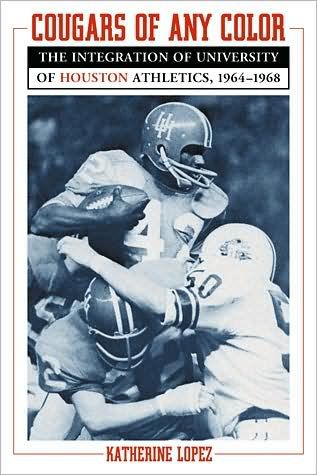Cougars of Any Color tells the story of the integration of UH athletics with the recruitment of Warren McVea for football and Elvin Hayes and Don Chaney for basketball.
The book begins with the story of integrating the University in general. Like most southern Universities, UH was an all-white institution. Unlike many universities, once integration finally occurred it was basically a non-event. There was no violence, no protests, and no decrease in enrollment.
Next the book provides a brief history of the football program including its attempts to join the Southwest Conference. For those Coogs who think of Rice as a lovable loser sister school, please listen to the story of Rice's actions when UH tried to join the SWC in 1964. Rice had agreed to be UH's sponsor, but they asked that UH not contact any other school for sponsorship. When it came time for consider UH's membership, Rice backed out and said that Houston belonged in a smaller conference with less competent schools. Due to Rice's backstabbing, UH was again left on the outside looking in.
The remainder of the book covers every aspect of integrating the UH basketball and football teams. And when I say the book covers every aspect, I mean EVERY aspect. It starts with the recruitment of the players from the high profile story of McVea to the relatively low profile stories of Hayes and Chaney. It tells of the newspapers' and opponents' reactions to that recruitment.
It covers the housing arrangements for the players and the on and off campus social life. It talks about the reaction of the African American community in Houston as well as some national reaction. It covers the reaction of the opponents's fans from booing, to racial taunts, to death threats. It covers the reaction of UH fans which in some cases also included booing and racial taunts, but also includes the embracing of these great athletes and Cougars.
Finally it covers the careers of the players. The coverage of the careers though is not solely from an athletics perspective. Their careers are considered for their impact on integration.
This book exceeded every expectation I had. I love Wizig's Eat 'Em Up, but it is almost a marketing piece with all positive stories. Written by a UH grad student, Cougars of Any Color could have easily followed that path. Starting off as a graduate thesis, it could also have turned into a very dry recitation of facts, but instead it is very entertaining.
The book prevents a very balanced story including both very positive and very negative aspects. One of the most amazing aspects of the book is the documentation of the facts and stories in the end notes. I guess I should expect that since it started as a thesis, but even the notes are sometimes entertaining. Reading the notes, I had wished this book was online instead of on paper because I wanted to open and read every newspaper or magazine article and listen to or watch every interview. I hope to follow up and read (or collect) many of the articles in the future.
Before I read this book, I really didn't understand UH's role in the integration of college athletics. UH fans are proud of our role, but I was concerned that they were overstated. After all, major programs in the north and west had already integrated. Schools like North Texas had also recruited African American athletes. UTEP won a basketball championship with an all African American starting lineup.
So how did UH contribute to the integration of college athletics in the South? The biggest impact may not have been having the players on the team, but it was who they played against. McVea was the first African American to play at an SEC stadium. That alone is an important footnote. It is also important that UH's African American players weren't just guys on the team. They were leaders and superstars. By having superstars playing in previously forbidden places, Southern teams realized that they could no longer recruit just White athletes if they wanted to remain elite. By seeing UH players on their fields and seeing that the world didn't end, it became a little more acceptable to consider adding players to their own teams.
So my recommendation? READ THIS BOOK!




2 comments:
I enjoyed the book too. I read it during my Hurricane Ike down time. Definitely a must read for anyone who is a student, alumni or fan of the Cougars.
Like you I was enthralled by the sources Ms. Lopez referred to. I'd love to get my hands on some of the articles and her some of the interviews she recorded.
Monkey Cage: I wish Houston Post and older Chronicle articles were archived online. Dallas Morning News articles go back to the 1800s.
The Denton Public Library system gives me access to several online newspaper archives that I love to go through every now and then.
Post a Comment